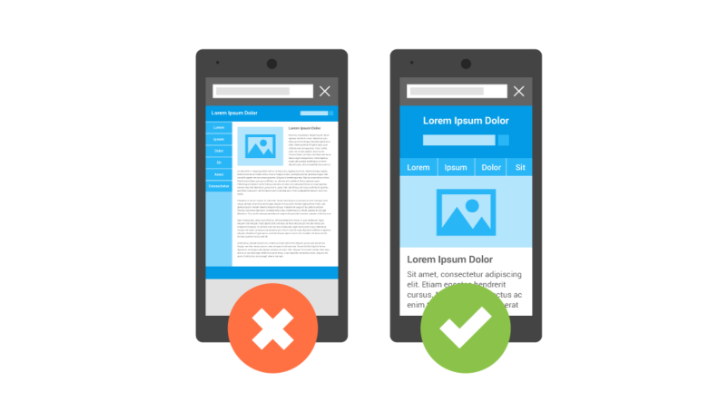The user experience (UX) in mobile is increasingly coming to the forefront as smartphones continue to dominate as the preferred device among users worldwide. UX encompasses all aspects of a user’s interaction with a company’s product or services, but in the mobile world, it’s even more crucial due to the smaller screens and limitations of mobile devices. Over the past decade, mobile devices have transformed the way we access information, shop, and interact with websites. According to Statista, in the first quarter of 2023, mobile devices (excluding tablets) generated 58.33% of global website traffic.
From the initial design planning to the final user journey, exceptional user experience is essential to ensure user satisfaction, engagement, and ultimately, high conversion rates. For instance, a well-designed mobile application or site helps to capture users’ attention, ensuring the ease of navigation, responsiveness, aesthetic appeal, and providing them with satisfying content. A mobile interface that understands its users, anticipates their needs, and allows for easy interaction, can profoundly influence the user’s perception of a brand or service. Similarly, a poor user experience can lead to frustration, decreasing perceived brand value and potentially causing users to abandon the platform altogether, thus impacting the bottom line. Whether you’re running an e-commerce store, a blog, or a corporate website, ensuring that your online presence is mobile-friendly is no longer optional—it’s a necessity.
What Is Mobile Optimisation?
Mobile optimisation is the process of ensuring that your website or online content is accessible, functional, and visually appealing on mobile devices, such as smartphones and tablets. It involves making design and performance adjustments to create a seamless and user-friendly experience for mobile users. Here are some key aspects of mobile optimisation:
1. Responsive Web Design
Responsive design has gained considerable traction in mobile user experience, mainly credited to the shift in user behaviour towards mobile browsing. This approach ensures that your website adapts to different screen sizes and resolutions, providing a consistent and visually appealing experience across various devices.
2. Mobile-Friendly Content
Content should be formatted and structured to be easily readable and navigable on smaller screens. This includes using readable fonts, optimising images, and using concise text.
When we dissect the essence of touch-friendly design, we first note that adequate spacing and sizing of elements are paramount. Buttons and links should be large enough to press without zooming in and spaced adequately to avoid accidental clicks. Equally important is the intuitiveness of gestures such as swiping, pinching, or tapping. Mobile applications should strive to align with user’s expectations and common navigation practices on mobile interfaces. It’s easy to overlook these intricacies in our quest for a visually remarkable design, but one must remember: functionality, in this case, is synonymous with utility and ultimately, user delight.
3. Fast Loading Times

Mobile users expect speed. With the proliferation of mobile technology in today’s digital age, speed and immediacy have become non-negotiable expectations from users. A fraction of a second can make a significant difference in whether a potential customer stays on your platform or moves on to a faster, more efficient one. Indeed, the rapidity with which a mobile application or website responds to a user’s interaction directly impacts the overall User Experience (UX).
From the onset, page load time comes into play. As simplified as it may sound, the quicker a page loads and presents the requested content, the better the User Experience. If a user has to wait for an extended period, their patience wears thin, and dissatisfaction kicks in, often resulting in high bounce rates.
4. Mobile-Optimised Forms
If your website requires user input or forms, they should be designed with mobile users in mind. Simplify forms, use autofill options, and minimise the need for excessive typing.
5. Simplified Navigation
Optimising the web navigation process plays a substantial part in enhancing user experience, and hence, boosting conversion rates. It is one of the key determinant elements of a successful mobile experience as it facilitates users to swiftly and easily locate what they are seeking.
When a user enters an app or a website, a clear, intuitive navigation system serves as a map leading them to their desired destination. By streamlining this process, businesses can effectively reduce the risk of user drop-off due to confusion or frustration, improving retention and engagement. More importantly, it directly impacts the conversion rate by making the pathway to purchase or sign-up smooth and hassle-free.
Why Mobile Optimisation Matters
1. Improved User Experience
A well-optimised mobile website provides a smoother and more enjoyable user experience. Visitors are more likely to stay on your site, engage with your content, and convert into customers when they can easily access and navigate your website on their mobile devices.

One of the key elements of a successful UX design is its capacity to enhance the user’s journey through strategic simplicity, intuitive navigation, and quick load times. Clear and effective calls-to-action are an essential part of this journey. A design that meets users’ needs immediately and provides ease of interaction inevitably invites conversion. Consequently, by prioritising a user’s experience, businesses can substantially augment not only their conversion rates but also client retention and brand loyalty.
2. Higher Conversion Rates
The ultimate goal of any online business is to convert visitors into customers or leads. Mobile optimisation directly impacts your conversion rates by reducing barriers to entry. When users can seamlessly browse and make purchases on their mobile devices, they are more likely to complete transactions.
3. Enhanced SEO Performance
Search engines, including Google, prioritise mobile-friendly websites in their search results. Mobile optimisation is a crucial factor in your website’s search engine ranking. By neglecting it, you risk losing visibility in search results and potential traffic.

4. Competitive Advantage
Businesses that invest in mobile-friendly websites gain a competitive edge over those that do not. Mobile users are more likely to engage with and return to businesses that cater to their needs.
5. Reduces Bounce Rates
Mobile optimisation helps reduce bounce rates, which occur when users quickly exit your website after encountering a poor mobile experience. Lower bounce rates indicate that visitors are finding value and staying on your site, increasing the likelihood of conversions.
Mobile Optimisation Best Practices
To harness the power of mobile optimisation, here are some best practices to implement:
- Conduct regular mobile testing on different devices and browsers.
The rapidly evolving nature of the digital landscape requires regular testing and updating of mobile applications to ensure optimal performance and usability. This iterative process is not merely a matter of maintaining the technical functionality but is also key in enhancing user experience (UX). It allows developers to address changes in user behaviour, new operating system updates, and evolving market trends, in a manner that is timely and relevant.
Regular testing allows for a comprehensive analysis of the mobile application in various aspects such as performance, accessibility, and functionality. It also enables developers to identify and fix bugs before they become problematic, thus ensuring a smooth user experience. On the other hand, frequent updates often encompass improved designs, additional features, or fresh content, which all contribute to keeping users engaged and satisfied. In the context of mobile UX, this ongoing process contributes to increased user satisfaction rates, user retention, and ultimately, higher conversion rates. Furthermore, regular testing and updates signal to users that the business is active, responsive, and committed to delivering a superior user experience.
- Prioritise page speed optimisation for mobile users.
The speed of functionality is critical, be it scrolling, swiping, or in-app transactions; all need to be seamless and fast. Even when a user makes a request, the server’s response time and the subsequent rendering of information on the screen must occur with alacrity. Anything less than swift and efficient would fail to meet user expectations and likely result in diminished returns.
- Implement responsive design principles.
If leveraged correctly, responsive design could significantly heighten the user experience, invariably leading to improved conversion rates.
- Implement effective Call-to-actions buttons.
The optimisation of mobile user experience goes beyond aesthetics and functionality. A crucial element that demands significant focus is the Call-to-Action (CTA) button. These buttons essentially act as signposts that guide customers through the buying journey, they also serve as the triggers that convert an interested visitor into a customer. This is why CTA buttons have a direct impact on conversion rates and also determine the success of the mobile platform.
- Optimise images and multimedia for mobile.
- Focus on a mobile-first approach in website design and development.

Impact of User Feedback on Improving Conversion
Surveys and user testing typically serve as vital inputs for the improvement of any product or service. In the realm of mobile user experience (UX), these inputs primarily come in the form of user feedback, which is rapidly gaining recognition for its potential to enhance conversion rates. User feedback principally has the power to reshape the way businesses understand user needs and behaviours, in addition to identifying existing bottlenecks and potential avenues for innovation and improvement.
Beginning with how user feedback is gathered, various tools and channels are implemented to collect qualitative and quantitative data from users. This might include direct outreach via email surveys, in-app push notifications, or even real-time user testing. Each interaction with the user holds the potential to gain valuable information regarding their experiences, pain points, and suggestions for enhancement. Following collection, this data is categorised, analysed, and applied to drive the enhancement of UX, ultimately boosting conversion rates. Each piece of feedback holds the potential to uncover user needs previously overlooked, pinpointing precise areas for improvement, from interface layout to navigation and content placement.
The Future Trends in Mobile User Experience.
Mobile user experience is poised for exciting developments as future trends shape its course significantly. Innovations in technology and the ever-evolving user expectations are the driving forces behind these emerging trends. Keeping pace with these new developments can create thrilling opportunities for businesses hoping to leverage this dynamic field in enhancing their mobile interface and meeting user needs. The promise of the future lies in the skilful harnessing and implementation of these trends.
Voice user interfaces (VUIs) and chatbots are rapidly gaining traction, bringing about a radical shift in how users interact with their mobile devices. The power of voice is its ability to simplify user interaction, saving time and allowing for multitasking, fundamentally improving the user experience. Another promising trend is the application of artificial intelligence (AI) and machine learning (ML) in user experience design. AI and ML can make apps smarter and more intuitive, personalising the user experience and enhancing engagement rates.

